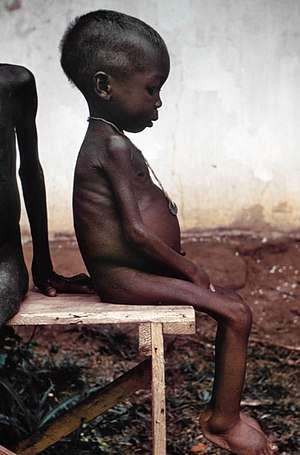Starvation
Starvation is a severe deficiency in caloric energy intake, below the level needed to maintain an organism's life. It is the most extreme form of malnutrition. In humans, prolonged starvation can cause permanent organ damage[1] and eventually, death. The term inanition refers to the symptoms and effects of starvation. Starvation may also be used as a means of torture or execution.
| Starvation | |
|---|---|
 | |
| A girl during the Nigerian Civil War of the late 1960s, shown suffering the effects of severe hunger and malnutrition. | |
| Specialty | Critical care medicine |
| Symptoms | feeling weak or tired, lack of energy, loss of consciousness |
| Complications | Anemia, low blood sugar, dangerously low blood pressure organ failure |
| Causes | Malnutrition |
| Diagnostic method | based on symptoms |
| Treatment | intensive care |
According to the World Health Organization, hunger is the single gravest threat to the world's public health.[2] The WHO also states that malnutrition is by far the biggest contributor to child mortality, present in half of all cases.[2] Undernutrition is a contributory factor in the death of 3.1 million children under five every year.[3] Figures on actual starvation are difficult to come by, but according to the Food and Agriculture Organization, the less severe condition of undernourishment currently affects about 842 million people, or about one in eight (12.5%) people in the world population.[4]
The bloated stomach represents a form of malnutrition called kwashiorkor. The exact pathogenesis of kwashiorkor is not clear, as initially it was thought to relate to diets high in carbohydrates (e.g. maize) but low in protein.[5] While many patients have low albumin, this is thought to be a consequence of the condition. Possible causes such as aflatoxin poisoning, oxidative stress, immune dysregulation and altered gut microbiota have been suggested.[6] Treatment can help mitigate symptoms such as the pictured weight loss and muscle wasting, however prevention is of utmost importance.[5]
Signs and symptoms

Early symptoms include impulsivity, irritability, and hyperactivity. Atrophy (wasting away) of the stomach weakens the perception of hunger, since the perception is controlled by the volume of the stomach that is empty. Individuals experiencing starvation lose substantial fat (adipose tissue) and muscle mass as the body breaks down these tissues for energy.[7] Catabolysis is the process of a body breaking down its own muscles and other tissues in order to keep vital systems such as the nervous system and heart muscle (myocardium) functioning.[8] The energy deficiency inherent in starvation causes fatigue and renders the victim more apathetic over time. As the starving person becomes too weak to move or even eat, their interaction with the surrounding world diminishes. In females, menstruation ceases when the body fat percentage is too low to support a fetus.
Victims of starvation are often too weak to sense thirst, and therefore become dehydrated. All movements become painful due to muscle atrophy and dry, cracked skin that is caused by severe dehydration. With a weakened body, diseases are commonplace. Fungi, for example, often grow under the esophagus, making swallowing painful. Vitamin deficiency is also a common result of starvation, often leading to anemia, beriberi, pellagra, and scurvy. These diseases collectively can also cause diarrhea, skin rashes, edema, and heart failure. Individuals are often irritable and lethargic as a result.
There is insufficient scientific data on exactly how long people can live without food.[9] Although the length of time varies with an individual's percentage of body fat and general health, one medical study estimates that in adults complete starvation leads to death within 8 to 12 weeks.[10] Starvation begins when an individual has lost about 30%, or about a third, of their normal body weight.[11] Once the loss reaches 40% death is almost inevitable.[11]
Causes
Starvation is an imbalance between energy intake and energy expenditure. The body expends more energy than it takes in. This imbalance can arise from one or more medical conditions or circumstantial situations, which can include:
Medical reasons
- Anorexia nervosa
- Bulimia nervosa
- Eating disorder, not otherwise specified
- Celiac disease
- Coma
- Major depressive disorder
- Diabetes mellitus
- Digestive disease
- Constant vomiting
Circumstantial causes
Biochemistry
With a typical high-carbohydrate diet, the human body relies on free blood glucose as its primary energy source. Glucose can be obtained directly from dietary sugars and by the breakdown of other carbohydrates. In the absence of dietary sugars and carbohydrates, glucose is obtained from the breakdown of stored glycogen. Glycogen is a readily-accessible storage form of glucose, stored in notable quantities in the liver and skeletal muscle.
After the exhaustion of the glycogen reserve, and for the next 2–3 days, fatty acids become the principal metabolic fuel. At first, the brain continues to use glucose. If a non-brain tissue is using fatty acids as its metabolic fuel, the use of glucose in the same tissue is switched off. Thus, when fatty acids are being broken down for energy, all of the remaining glucose is made available for use by the brain.
After 2 or 3 days of fasting, the liver begins to synthesize ketone bodies from precursors obtained from fatty acid breakdown. The brain uses these ketone bodies as fuel, thus cutting its requirement for glucose. After fasting for 3 days, the brain gets 30% of its energy from ketone bodies. After 4 days, this may go upwards to 70% or more.[14] Thus, the production of ketone bodies cuts the brain's glucose requirement from 80 g per day to 30 g per day, about 35% of normal, with 65% derived from ketone bodies. But of the brain's remaining 30 g requirement, 20 g per day can be produced by the liver from glycerol (itself a product of fat breakdown). But this still leaves a deficit of about 10 g of glucose per day that must be supplied from some other source. This other source will be the body's own proteins.
After exhaustion of fat stores, the cells in the body begin to break down protein. This releases alanine and lactate produced from pyruvate into the bloodstream, which can be converted into glucose by the liver. Since much of human muscle mass is protein, this phenomenon is responsible for the wasting away of muscle mass seen in starvation. However, the body is able to selectively decide which cells will break down protein and which will not. About 2–3 g of protein has to be broken down to synthesize 1 g of glucose; about 20–30 g of protein is broken down each day to make 10 g of glucose to keep the brain alive. However, this number may decrease the longer the fasting period is continued in order to conserve protein.
Starvation ensues when the fat reserves are completely exhausted and protein is the only fuel source available to the body. Thus, after periods of starvation, the loss of body protein affects the function of important organs, and death results, even if there are still fat reserves left unused. (In a leaner person, the fat reserves are depleted faster, the protein depletion occurs sooner, and therefore death occurs sooner.) The ultimate cause of death is, in general, cardiac arrhythmia or cardiac arrest brought on by tissue degradation and electrolyte imbalances. Alternatively, things like metabolic acidosis may also cause death in starving people.[15]
Prevention
Starvation can be caused by factors, other than illness, outside of the control of the individual. The Rome Declaration on World Food Security outlines several policies aimed at increasing food security[16] and, consequently, preventing starvation. These include:
- Poverty reduction
- Prevention of wars and political instability
- Food aid[17]
- Agricultural sustainability
- Reduction of economic inequality
Supporting farmers in areas of food insecurity through such measures as free or subsidized fertilizers and seeds increases food harvest and reduces food prices.[18]
Treatment
Patients that suffer from starvation can be treated, but this must be done cautiously to avoid refeeding syndrome.[19] Rest and warmth must be provided and maintained. Small sips of water mixed with glucose should be given in regular intervals. Fruit juices can also be given. Later, food can be given gradually in small quantities. The quantity of food can be increased over time. Proteins may be administered intravenously to raise the level of serum proteins.[20]
Organizations
Many organizations have been highly effective at reducing starvation in different regions. Aid agencies give direct assistance to individuals, while political organizations pressure political leaders to enact more macro-scale policies that will reduce famine and provide aid.
Statistics
According to estimates by the Food and Agriculture Organization there were 925 million under- or malnourished people in the world in 2010.[21] This was a decrease from an estimate of roughly 1 billion malnourished people in 2009.[22] In 2007, 923 million people were reported as being undernourished, an increase of 80 million since 1990–92.[23] An estimated 820 million people did not have enough to eat in 2018, up from 811 million in the previous year, which is the third year of increase in a row.[24]
As the definitions of starving and malnourished people are different, the number of starving people is different from that of malnourished. Generally, far fewer people are starving, than are malnourished.
The proportion of malnourished and of starving people in the world has been more or less continually decreasing for at least several centuries.[25] This is due to an increasing supply of food and to overall gains in economic efficiency. In 40 years, the proportion of malnourished people in the developing world has been more than halved. The proportion of starving people has decreased even faster.
| Year | 1970 | 1980 | 1990 | 2004 | 2007 | 2009 |
|---|---|---|---|---|---|---|
| Proportion of undernourished people in the less-developed world[22][26][27] | 37 % | 28 % | 20 % | 16 % | 17 % | 16 % |
Capital punishment
| Wikisource has original text related to this article: |

From a drawing by André Castagne
Historically, starvation has been used as a death sentence. From the beginning of civilization to the Middle Ages, people were immured, or walled in, and would die for want of food.
In ancient Greco-Roman societies, starvation was sometimes used to dispose of guilty upper class citizens, especially erring female members of patrician families. For instance, in the year 31, Livilla, the niece and daughter-in-law of Tiberius, was discreetly starved to death by her mother for her adulterous relationship with Sejanus and for her complicity in the murder of her own husband, Drusus the Younger.
Another daughter-in-law of Tiberius, named Agrippina the Elder (a granddaughter of Augustus and the mother of Caligula), also died of starvation, in 33 AD. (However, it is not clear whether her starvation was self-inflicted.)
A son and daughter of Agrippina were also executed by starvation for political reasons; Drusus Caesar, her second son, was put in prison in 33 AD, and starved to death by orders of Tiberius (he managed to stay alive for nine days by chewing the stuffing of his bed); Agrippina's youngest daughter, Julia Livilla, was exiled on an island in 41 by her uncle, Emperor Claudius, and subsequently her death by starvation was arranged by the empress Messalina.
It is also possible that Vestal Virgins were starved when found guilty of breaking their vows of celibacy.
Ugolino della Gherardesca, his sons and other members of his family were immured in the Muda, a tower of Pisa, and starved to death in the thirteenth century. Dante, his contemporary, wrote about Gherardesca in his masterpiece The Divine Comedy.
In Sweden in 1317, King Birger of Sweden imprisoned his two brothers for a coup they had staged several years earlier (Nyköping Banquet). According to legend they died of starvation a few weeks later, since their brother had thrown the prison key in the castle moat.
In Cornwall in the UK in 1671, John Trehenban from St Columb Major was condemned to be starved to death in a cage at Castle An Dinas for the murder of two girls. The Makah, a Native American tribe inhabiting the Pacific Northwest near the modern border of Canada and the United States, practiced death by starvation as a punishment for slaves.[28]
Concentration camps and ghettos

Many of the prisoners died in the Nazi concentration camps through deliberate maltreatment, disease, starvation, and overwork, or were executed as unfit for labor. Many occupants of ghettos in eastern Europe also starved to death, most notoriously in the Warsaw Ghetto in German-occupied Poland. Prisoners were transported in inhumane conditions by rail freight cars, in which many died before reaching their destination. The prisoners were confined to the cattle cars for days or even weeks, with little or no food or water. Many died of dehydration in the intense heat of summer or froze to death in winter. Nazi concentration camps in Europe from 1933 to 1945 deliberately underfed prisoners, who were at the same time forced to perform heavy labour. Their diet was restricted to watery vegetable soup and a little bread, with little to no dietary fats, proteins or other essential nutrients. Such treatment led to loss of body tissues, and when prisoners became skeletal, the so-called Muselmann were murdered by gas or bullets when examined by camp doctors.

Starvation was also used as a punishment where victims were locked into a small cell until dead, a process which could take many days. Saint Maximilian Kolbe, a martyred Polish friar, underwent a sentence of starvation in Auschwitz concentration camp in 1941. Ten prisoners had been condemned to death by starvation in the wake of a successful escape from the camp. Kolbe volunteered to take the place of a man with a wife and children. After two weeks of starvation, Kolbe and three other inmates remained alive; they were then executed with injections of phenol.
See also
- 2007-2008 world food price crisis
- Anorexia mirabilis
- Norman Borlaug
- Cachexia
- Catharistic endura rite
- Global Hunger Index
- Starvation mode
- Famine scales
- Hunger Plan
- Hunger strike
- List of famines
- List of people who died of starvation
- Marasmus
- Muselmann
- Human overpopulation
- Santhara
References
- Disease-Related Malnutrition: An Evidence-Based Approach to Treatment "When [food] intake is poor or absent for a long time (weeks), weight loss is associated with organ failure and death."
- Malnutrition The Starvelings
- "Hunger Stats". World Food Programme.
- FAO: The State of Food Insecurity in the World
- "Archived copy". Archived from the original on 2011-10-02. Retrieved 2011-06-26.CS1 maint: archived copy as title (link)
- "Protein-Energy Malnutrition | Nutrition Guide for Clinicians". PCRM's nutrition guide for clinicians. PCRM. Retrieved 16 April 2019.
- "With spirulina, and together, we will end child malnutrition in the world. Now". Retrieved Dec 16, 2014.
- Cahill, G. F. (1998). "Survival in starvation". The American Journal of Clinical Nutrition. 68 (1): 1–2. doi:10.1093/ajcn/68.1.1. PMID 9665088.
- Hoffman, Matthew (2014). "How long can you live without food?". Answers. WebMD, LLC. Retrieved October 5, 2014.
- Bernhard, Virginia (2011). A Tale of Two Colonies: What Really Happened in Virginia and Bermuda?. University of Missouri Press. pp. 112. ISBN 978-0826272577.
how long does it take to starve to death.
- Time magazine, November 11, 1974, cited in Pojman, Paul; Pojman, Louis (2011). Food Ethics. Cengage Learning. p. 128. ISBN 978-1111772307.
- Howe Bancroft, Hubert (1883). "North American states. 1883". History of the Pacific States of North America. A.L. Bancroft,1883. 10: 411.
- Taylor, Charles (1811). "The Literary Panorama, Volume 10". The Literary Panorama. 10: 539.
- C. J. Coffee (Dec 1, 2004). Quick Look: Metabolism. Hayes Barton Press. p. 169.
- Toth, HL; Greenbaum, LA (November 2003). "Severe acidosis caused by starvation and stress". American Journal of Kidney Diseases. 42 (5): E16-9. PMID 14582074.
- World Food Summit - Rome Declaration on World Food Security
- Laird Birmingham, C. (2000). "Child hunger: semi-starvation study repeated in Canada". Canadian Medical Association Journal. 163 (8): 985–986. PMC 80547. PMID 11068570.
- Ending Famine, Simply by Ignoring the Experts
- Mehanna HM, Moledina J, Travis J (June 2008). "Refeeding syndrome: what it is, and how to prevent and treat it". BMJ. 336 (7659): 1495–8. doi:10.1136/bmj.a301. PMC 2440847. PMID 18583681.
- "The Physiology and Treatment of Starvation". Proceedings of the Royal Society of Medicine. US national library of medicine. 38 (7): 388–398. 1945. PMC 2181967. PMID 19993083.
- FAO:Hunger
- The State of Food Insecurity in the World, 2010: Addressing Food Insecurity in Protracted Crises
- Food and Agriculture Organization Economic and Social Development Department. "The State of Food Insecurity in the World, 2008 : High food prices and food security - threats and opportunities". Food and Agriculture Organization of the United Nations, 2008, p. 2. "FAO’s most recent estimates put the number of hungry people at 923 million in 2007, an increase of more than 80 million since the 1990–92 base period.".
- https://www.who.int/news-room/detail/15-07-2019-world-hunger-is-still-not-going-down-after-three-years-and-obesity-is-still-growing-un-report
- Fogel, RW (2004). The escape from hunger and premature death, 1700-2100: Europe, America, and the Third World. Cambridge: Cambridge University Press.
- Food and Agriculture Organization Agricultural and Development Economics Division. "The State of Food Insecurity in the World, 2006 : Eradicating world hunger – taking stock ten years after the World Food Summit". Food and Agriculture Organization of the United Nations, 2006, p. 8. "Because of population growth, the very small decrease in the number of hungry people has nevertheless resulted in a reduction in the proportion of undernourished people in the developing countries by 3 percentage points – from 20 percent in 1990–92 to 17 percent in 2001–03. (…) the prevalence of undernourishment declined by 9 percent (from 37 percent to 28 percent) between 1969–71 and 1979–81 and by a further 8 percentage points (to 20 percent) between 1979–81 and 1990–92.".
- Food and Agriculture Organization Economic and Social Development Department. "The State of Food Insecurity in the World, 2008 : High food prices and food security - threats and opportunities". Food and Agriculture Organization of the United Nations, 2008, p. 6. "Good progress in reducing the share of hungry people in the developing world had been achieved – down from almost 20 percent in 1990–92 to less than 18 percent in 1995–97 and just above 16 percent in 2003–05. The estimates show that rising food prices have thrown that progress into reverse, with the proportion of undernourished people worldwide moving back towards 17 percent.".
- Donald, Leland (1997). Aboriginal Slavery on the Northwest Coast of North America, University of California Press, p. 23
Further reading
| Wikimedia Commons has media related to Starvation. |
| Wikiquote has quotations related to: Starvation |
- Online books, and library resources in your library and in other libraries about Starvation
- U.N. Chief: Hunger Kills 17,000 Kids Daily - by CNN
- Wilson, DE; Zeikus, R; Chan, IF (Apr 1987). "Relationship of organ lipoprotein lipase activity and ketonuria to hypertriglyceridemia in starved and streptozocin-induced diabetic rats". Diabetes. 36 (4): 485–90. doi:10.2337/diabetes.36.4.485. PMID 3817303.
- Swaner, JC; Connor, WE (Aug 1975). "Hypercholesterolemia of total starvation: its mechanism via tissue mobilization of cholesterol". The American Journal of Physiology. 229 (2): 365–9. doi:10.1152/ajplegacy.1975.229.2.365. PMID 169705.
| Classification |
|---|